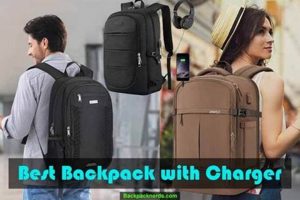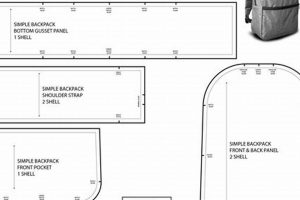Oversized carrying solutions designed for substantial cargo are the subject of this exposition. These specialized pieces of equipment offer significantly greater capacity than standard models, frequently exceeding 70 liters. An example of their utility includes extended backpacking trips, where individuals require ample space for tents, sleeping bags, cooking equipment, and multiple days’ worth of provisions.
The importance of these high-capacity carriers stems from their ability to consolidate numerous smaller bags into a single, manageable unit. This consolidation enhances mobility and reduces the overall burden on the user. Historically, such equipment evolved from military rucksacks and mountaineering packs, reflecting the need for durable and capacious load-bearing options in demanding environments. Their ergonomic design and robust construction contribute to comfort and longevity, making them valuable assets for varied applications.
The following sections will delve into the key considerations for selecting appropriate high-volume carrying solutions. These considerations encompass factors such as material composition, suspension systems, organizational features, and intended use cases, providing a comprehensive guide to informed decision-making.
Guidance on Selecting High-Capacity Carriers
The following outlines essential considerations when evaluating oversized rucksacks for optimal performance and suitability to specific needs.
Tip 1: Prioritize Durability. Material selection is paramount. Opt for robust fabrics like ripstop nylon or Cordura, capable of withstanding abrasion, tears, and prolonged exposure to environmental elements. Reinforced stitching and durable zippers are also crucial indicators of overall longevity.
Tip 2: Assess Suspension System Quality. A well-designed suspension system is critical for weight distribution and comfort. Look for adjustable torso lengths, padded shoulder straps, and a supportive hip belt. Internal frames made of aluminum or composite materials offer superior load-bearing capabilities.
Tip 3: Evaluate Organizational Features. Multiple compartments, pockets, and attachment points enhance cargo management. Consider the specific items requiring storage and ensure the chosen model provides dedicated spaces for frequently accessed items, such as water bottles, maps, and first-aid kits.
Tip 4: Consider Intended Use. Match the pack’s features to the anticipated activities. Backpacking requires robust weather protection and ample capacity for camping gear. Travel may necessitate lockable zippers and discreet profiles. Specialized activities, such as climbing or skiing, demand specific attachment points for equipment.
Tip 5: Analyze Weight and Volume. Empty weight should be minimized without sacrificing durability. Carefully assess the required volume, measured in liters, to ensure sufficient space for all essential gear. Overpacking can lead to discomfort and reduced mobility.
Tip 6: Verify Fit. Proper fit is essential for comfort and preventing injuries. Ideally, try on the loaded carrier before purchase to assess weight distribution and ensure the hip belt sits comfortably on the hips, transferring the majority of the load. Adjustability is key to achieving an optimal fit.
The application of these guidelines ensures an informed purchasing decision, leading to enhanced comfort, improved performance, and increased satisfaction when utilizing high-capacity load-carrying equipment.
The subsequent section presents a conclusion summarizing the key aspects discussed within this article.
1. Capacity (Volume)
Capacity, quantified as volume, serves as the defining characteristic of oversized carrying solutions. The increased capacity of these implements directly addresses the need for transporting substantial quantities of equipment or supplies. A direct correlation exists: a higher volume capacity allows for the inclusion of more items. As such, the selection of a backpack’s volume is predicated upon the quantity and dimensions of the load it is designed to accommodate. For example, a mountaineering expedition necessitates significantly more capacity than a day hike, owing to the requirement for specialized equipment such as ropes, ice axes, and advanced camping gear.
The importance of capacity extends beyond simple storage; it influences load distribution, stability, and overall comfort during use. An improperly sized carrier, either too small or excessively large, can compromise balance and lead to physical strain. Consider a researcher conducting field work in a remote location. A properly sized, high-volume backpack is crucial for carrying scientific equipment, samples, and survival necessities. Insufficient capacity could require multiple trips, increasing the risk of accidents and delays. A backpack with an excessive capacity can lead to the carrying of unnecessary equipment, therefore impacting efficiency and mobility.
In summary, the volume capacity of an oversized backpack is not merely a measure of its internal space, but a key determinant of its functionality and suitability for specific applications. The challenges inherent in balancing capacity requirements with ergonomic design and load-bearing limitations must be carefully considered to ensure optimal performance and user safety. Proper assessment of these factors will lead to informed decisions when selecting oversized carrying equipment for diverse professional and recreational pursuits.
2. Load Bearing
The functionality of oversized carrying solutions is intrinsically linked to load bearing capacity. The expanded volume inherent in these designs necessitates a robust structural framework capable of supporting substantial weight. The relationship is causal: increased volume directly correlates with the potential for increased load, placing greater demands on the pack’s frame, suspension system, and material integrity. Load bearing, in this context, is not merely a matter of preventing structural failure; it encompasses the ability to distribute weight effectively, minimizing strain on the user and maintaining stability during movement. For example, a geological survey team transporting rock samples and surveying equipment in a mountainous terrain relies on the load-bearing capabilities of their backpacks to maintain balance and maneuverability, mitigating the risk of falls and injuries. The understanding of this connection is thus practically significant, guiding design choices in material selection and structural reinforcement.
Further analysis reveals that load bearing is not a static characteristic; it is influenced by factors such as weight distribution, pack dimensions, and the user’s physical attributes. An improperly loaded pack can compromise the effectiveness of even the most robust suspension system. Consider the scenario of an emergency medical technician responding to a remote wilderness incident. The load, comprised of medical supplies, communication equipment, and personal protective gear, must be carefully organized to ensure even weight distribution. Failure to do so can result in asymmetrical strain, leading to fatigue, reduced mobility, and potentially compromising the EMT’s ability to provide timely medical assistance. The ability to accommodate heavy loads also presents opportunities for use in logistical operations, allowing for the efficient transport of essential supplies in areas where traditional vehicles are not viable.
In summary, the relationship between load bearing and oversized carrying solutions is paramount to effective design and application. Effective weight distribution is essential for user comfort and safety. The challenge lies in balancing high-volume capacity with a robust load-bearing design, ensuring that the carrier can withstand significant weight without compromising stability or ergonomic integrity. A thorough understanding of the mechanics of load bearing is essential for manufacturers, end-users, and professionals involved in the selection and application of these specialized pieces of equipment.
3. Ergonomic Design
Ergonomic design constitutes a critical determinant of the usability and safety of oversized carrying solutions. The expanded volume and potential weight associated with such packs necessitate a design approach that prioritizes the efficient distribution of load, reduction of strain, and promotion of user comfort. The connection between ergonomic principles and backpack design is direct: inadequate ergonomic considerations can lead to musculoskeletal injuries, fatigue, and reduced overall performance, particularly during extended use. For example, a poorly designed pack lacking proper lumbar support and adjustable shoulder straps can concentrate weight on specific pressure points, resulting in back pain, shoulder strain, and impaired gait. Conversely, an ergonomically sound design evenly distributes weight across the skeletal structure, minimizing stress and enabling a more natural range of motion. The importance of this consideration becomes magnified in professional settings, where extended periods of load carriage are routine, such as in military operations or wilderness search and rescue. An appropriately designed pack, coupled with proper training and conditioning, is therefore crucial for mitigating the risk of injury and enhancing operational effectiveness.
The practical application of ergonomic principles manifests in various design features. Adjustable torso lengths allow users to customize the pack to their individual body dimensions, ensuring optimal weight distribution. Padded shoulder straps and hip belts provide cushioning and reduce pressure points, enhancing comfort during prolonged use. Internal frames, constructed from lightweight yet durable materials such as aluminum or carbon fiber, provide structural support and prevent the pack from collapsing under heavy loads. Furthermore, the strategic placement of compartments and attachment points facilitates efficient load organization, minimizing shifting and maintaining balance. Consider the design of a search and rescue pack, which incorporates multiple external pockets for readily accessible items such as first aid supplies, GPS devices, and communication equipment. The organization of the gear allows the rescuer to focus on navigating through rough terrain and providing prompt medical assistance rather than fumbling for equipment. The implementation of these design details provides direct feedback to users in terms of enhanced comfort, stability, and reduced risk of injuries.
In summary, ergonomic design is not merely an aesthetic consideration but a fundamental requirement for oversized carrying solutions. Its integration into the design process directly impacts user comfort, safety, and performance. By understanding the biomechanical principles underlying ergonomic design, manufacturers and end-users can collaborate to develop and select packs that minimize the risk of injury, maximize efficiency, and enhance the overall carrying experience. The challenge lies in continually innovating and refining ergonomic design principles to address the evolving needs of diverse users in a wide range of applications, ensuring that the burden of carrying essential equipment is minimized.
4. Material Strength
The inherent capacity of oversized carrying solutions introduces a direct correlation with the concept of material strength. The greater volume afforded by these specialized carrying devices presents a proportional increase in the potential weight and bulk of transported goods. This, in turn, necessitates a robust material composition capable of withstanding significant tensile, tear, and abrasive forces. The selection of materials possessing inadequate strength characteristics directly compromises the functionality and longevity of the pack, leading to premature failure under load. For instance, the use of a lightweight, low-denier nylon in the construction of a high-volume backpack intended for extended wilderness expeditions would predictably result in seam rupture, fabric tearing, and compromised structural integrity upon encountering the rigors of the environment. Therefore, the assessment and specification of appropriate material strength are paramount to ensuring the reliability and durability of such equipment.
The practical application of material strength considerations involves a multifaceted evaluation of fabric properties, weave patterns, and coating technologies. High-tenacity nylon, often reinforced with ripstop weaves, is frequently employed due to its favorable strength-to-weight ratio and resistance to abrasion. The inclusion of polyurethane or silicone coatings further enhances water resistance and extends the lifespan of the fabric. Consider the construction of military-grade rucksacks, which are subjected to extreme conditions and demanding load requirements. These packs commonly utilize heavy-duty Cordura nylon, exceeding 1000 denier, to ensure exceptional durability and resistance to tearing, puncture, and wear. Furthermore, reinforced stitching and bar-tacked stress points contribute to the overall structural integrity of the pack, mitigating the risk of failure under heavy loads.
In summary, material strength represents a foundational element in the design and performance of oversized carrying solutions. The selection of appropriate materials, characterized by high tensile strength, tear resistance, and abrasion resistance, directly impacts the reliability, durability, and safety of the pack. By adhering to stringent material specifications and employing advanced manufacturing techniques, manufacturers can ensure that these critical pieces of equipment are capable of withstanding the demanding conditions encountered in diverse professional and recreational applications. The challenge lies in continually innovating and developing new materials that offer enhanced strength characteristics without compromising weight or flexibility, thereby advancing the capabilities of oversized carrying solutions for the benefit of users across a broad spectrum of activities.
5. Compartmentalization
Compartmentalization, a critical design element in oversized carrying solutions, directly enhances organizational efficiency and load distribution within the expanded volume. The absence of discrete compartments in large-capacity packs leads to chaotic contents, hindering accessibility and potentially causing uneven weight distribution. This uneven distribution increases user fatigue and reduces stability. For example, a photographer carrying equipment in a large backpack without designated compartments risks damaging sensitive lenses and cameras due to internal collisions and shifting. Proper compartmentalization mitigates this risk, providing dedicated spaces for specific items, thereby protecting the contents and promoting balanced load carriage. Therefore, the presence and design of compartments within extra-large backpacks have a direct causal relationship with the user’s ability to effectively manage and transport their gear.
The practical application of compartmentalization extends beyond mere organization; it directly impacts access speed and operational effectiveness. Military personnel, for instance, rely on compartmentalized backpacks to rapidly retrieve essential equipment such as medical supplies, ammunition, and communication devices in high-stress situations. The strategic placement of compartments, often tailored to specific mission requirements, minimizes search time and allows for swift and decisive action. Similarly, researchers conducting field work in remote locations utilize compartmentalized packs to separate delicate instruments from potentially contaminating samples, ensuring data integrity and preventing cross-contamination. The presence of readily accessible compartments for frequently used items, such as water bottles or navigation tools, further contributes to operational efficiency and enhances user convenience. This emphasizes the real-world value of thoughtful compartmentalization in extra-large backpacks.
In summary, compartmentalization represents a key factor influencing the usability and effectiveness of oversized carrying solutions. Its impact extends from enhancing organizational efficiency and load distribution to facilitating rapid access to essential equipment and mitigating risks of damage or contamination. The challenge lies in optimizing compartment design to accommodate diverse user needs while maintaining structural integrity and minimizing unnecessary weight. Continued innovation in compartmentalization strategies will further enhance the functionality and appeal of extra-large backpacks for a wide range of applications, from professional endeavors to recreational pursuits.
6. Weather Resistance
The inherent volume of oversized carrying solutions necessitates robust weather resistance as a critical design parameter. The expansive internal space, designed to accommodate substantial quantities of equipment, simultaneously presents a greater surface area exposed to environmental elements. Consequently, the integration of effective weather-resistant features is paramount to safeguarding contents from precipitation, humidity, and other potentially damaging atmospheric conditions.
- Fabric Waterproofing and Coatings
The selection of waterproof or water-resistant fabrics, such as high-denier nylon or polyester treated with durable water repellent (DWR) coatings, forms the primary line of defense. These materials effectively impede the ingress of moisture, preventing saturation of the pack’s interior. Example: Backpacks intended for alpine mountaineering utilize fabrics laminated with waterproof membranes to withstand prolonged exposure to snow and rain. Implications: Compromised waterproofing leads to dampened gear, increased weight, and potential damage to sensitive equipment.
- Seam Sealing and Construction Techniques
Even with waterproof fabrics, seams represent vulnerable points for water penetration. Seam sealing, employing specialized tapes or liquid sealants applied to the interior of the seams, mitigates this risk. Welded or bonded construction techniques further minimize potential entry points. Example: Whitewater rafting packs feature fully sealed seams to ensure complete watertightness during prolonged submersion. Implications: Inadequate seam sealing negates the effectiveness of waterproof fabrics, resulting in leaks and water damage.
- Closure Systems and Storm Flaps
The main compartment closure and any external pockets or access points require weather-resistant closures to prevent water intrusion. Zippers, protected by storm flaps or water-resistant coatings, and roll-top closures offer varying degrees of protection. Example: Backpacks designed for extended backpacking trips in variable climates utilize roll-top closures and overlapping storm flaps to shield contents from heavy rain and snow. Implications: Substandard closure systems compromise weather resistance, allowing water to enter the pack through openings and zippers.
- Bottom Panel Reinforcement and Protection
The bottom panel of the backpack, subject to abrasion and exposure to wet surfaces, requires reinforcement and additional weather protection. Durable, waterproof materials and raised feet or bumpers prevent direct contact with the ground. Example: Backpacks utilized by researchers in wet environments, such as rainforests, feature reinforced bottom panels with waterproof coatings to prevent moisture wicking from the ground. Implications: Neglecting bottom panel protection leads to water absorption from below, saturating the contents and accelerating material degradation.
These facets, when comprehensively addressed, collectively contribute to the overall weather resistance of oversized carrying solutions. Failure to adequately incorporate these features compromises the pack’s ability to protect valuable contents from environmental hazards. The design and selection of extra-large backpacks, therefore, must prioritize weather resistance as a fundamental performance characteristic.
7. Adjustability
Adjustability represents a crucial design parameter in oversized carrying solutions, impacting user comfort, load distribution, and overall stability. The inherent variability in human body dimensions necessitates adjustable features to ensure a customized fit, maximizing the ergonomic benefits and mitigating potential strain associated with carrying heavy loads. The absence of adjustability compromises the effectiveness of the pack, potentially leading to discomfort, injury, and reduced performance.
- Torso Length Adjustment
Torso length adjustment allows users to match the pack’s frame to their individual torso measurement, ensuring that the hip belt rests correctly on the iliac crest, effectively transferring weight from the shoulders to the hips. Example: Adjustable torso systems often employ sliding shoulder harness mechanisms or interchangeable frame components. Implications: An improperly fitted torso length results in uneven weight distribution, placing undue stress on the shoulders or lower back, leading to discomfort and potential musculoskeletal issues.
- Shoulder Strap Adjustment
Shoulder strap adjustment enables precise tuning of strap length and angle, optimizing comfort and preventing slippage. Load lifter straps, connecting the top of the shoulder straps to the frame, further enhance weight distribution and prevent the pack from pulling away from the body. Example: Fine-grained adjustment buckles and load lifter straps allow users to customize the fit based on varying load weights and terrain conditions. Implications: Insufficient shoulder strap adjustability leads to chafing, pressure points, and an unstable load, compromising mobility and increasing fatigue.
- Hip Belt Adjustment
Hip belt adjustment allows users to securely fasten the hip belt around their waist, transferring the majority of the pack’s weight to the hips. Adjustable hip belt padding and angle further enhance comfort and accommodate varying body shapes. Example: Interchangeable hip belt pads and adjustable buckle positions enable users to fine-tune the fit for optimal comfort and weight distribution. Implications: An improperly fitted hip belt fails to effectively transfer weight to the hips, placing excessive strain on the shoulders and lower back, increasing the risk of injury.
- Load Stabilization Straps
Load stabilization straps, located on the sides and bottom of the pack, compress the contents, minimizing shifting and enhancing stability. These straps allow users to secure loose items and prevent them from moving around during activity. Example: Compression straps are frequently used to secure sleeping bags, tents, and other bulky items, preventing them from shifting and disrupting balance. Implications: Inadequate load stabilization results in an unstable and unbalanced pack, increasing the risk of falls and compromising mobility, particularly on uneven terrain.
These adjustable features, when properly utilized, significantly enhance the comfort, stability, and performance of oversized carrying solutions. The capacity to customize the fit to individual body dimensions and load requirements ensures optimal weight distribution and minimizes the risk of injury. The implementation of these features reflects a commitment to user-centric design, prioritizing ergonomic considerations and maximizing the benefits of extra-large backpacks for a wide range of activities and applications.
Frequently Asked Questions
This section addresses common inquiries regarding the selection, utilization, and maintenance of high-capacity rucksacks, aiming to provide clarity and informed decision-making.
Question 1: What capacity, in liters, constitutes an “extra large” backpack?
The categorization typically begins at approximately 70 liters and extends upwards, often exceeding 100 liters. The specific demarcation may vary depending on manufacturer and intended use.
Question 2: What constitutes a safe maximum load weight for high-capacity carrying solutions?
The appropriate load weight depends on individual physical capabilities and the pack’s design. A general guideline suggests limiting the load to no more than 25-30% of the user’s body weight. Consult the manufacturer’s specifications for the recommended maximum load.
Question 3: What materials are best suited for the construction of heavy-duty backpacks intended for rigorous use?
Durable materials such as high-denier nylon (e.g., Cordura) and ripstop nylon are commonly employed due to their abrasion resistance, tear strength, and water resistance. Reinforced stitching and durable zippers are also crucial.
Question 4: How often should extra large backpacks undergo cleaning and maintenance procedures?
Cleaning frequency depends on usage and environmental conditions. After exposure to dirt, mud, or salt water, a thorough cleaning with mild soap and water is recommended. Regular inspection for damage and proper storage can extend the pack’s lifespan.
Question 5: What is the proper method for packing an oversized backpack to ensure optimal weight distribution and stability?
Heavier items should be positioned close to the spine and centered within the pack to maintain balance. Lighter items can be placed towards the top and sides. Utilize compression straps to minimize shifting and stabilize the load.
Question 6: Are high-capacity backpacks suitable for air travel as checked baggage?
While possible, oversized backpacks may be subject to size and weight restrictions imposed by airlines. It is advisable to check with the airline regarding specific baggage policies before traveling.
Key takeaways include recognizing the volume-weight considerations and construction for a durable and efficient carrying solutions.
The following section provides a conclusion, summarizing key points and offering final considerations for the selection and use of extra large backpacks.
Conclusion
This exposition has addressed the essential facets of extra large backpacks, underscoring their design considerations, material specifications, ergonomic principles, and practical applications. A clear understanding of volume, load bearing, weather resistance, and adjustability is paramount for informed selection. The information presented aims to equip individuals with the knowledge necessary to evaluate and utilize these high-capacity carrying solutions effectively.
The judicious choice of extra large backpacks represents a critical investment in efficiency, comfort, and safety. Careful evaluation of individual needs, coupled with a comprehensive understanding of the principles outlined, will ensure optimal performance in demanding environments. Future advancements in materials and design will continue to refine these carrying solutions, further enhancing their utility and durability for both professional and recreational applications.


![Best State Backpack [Year]: Your Ultimate Guide! Ultimate Backpack Traveler Guide: Tips, Destinations & Budget Hacks Best State Backpack [Year]: Your Ultimate Guide! | Ultimate Backpack Traveler Guide: Tips, Destinations & Budget Hacks](https://backpack-traveler.com/wp-content/uploads/2025/12/th-652-300x200.jpg)




